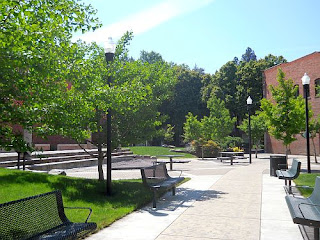 |
| Brackenbury Square in Lewiston, Idaho |
 This one-way street will take
motorists by Brackenbury Square, named in honor of a Lewiston resident who
overcame adversities to thrive in this town. The entrance to this small park is
marked by a statue of children playing in a fountain. Take time to enjoy the
serenity of this small square; be warned, though, on-street parking sometimes can
be difficult to find.
This one-way street will take
motorists by Brackenbury Square, named in honor of a Lewiston resident who
overcame adversities to thrive in this town. The entrance to this small park is
marked by a statue of children playing in a fountain. Take time to enjoy the
serenity of this small square; be warned, though, on-street parking sometimes can
be difficult to find.
Mary Case Brackenbury grew up
in Lewiston’s Hotel Idaho that was owned by her parents. Using the name Launi, she
became a professional Polynesian dancer on the vaudeville circuit. In 1953,
after dancing at a March of Dimes fundraiser, she was stricken with polio and
placed in an iron lung. After a lengthy recovery, she came back to the Hotel
Idaho to run the hotel, raise three children and care for her mother. Her
husband, Rod Brackenbury, died from wasp stings on a 1957 hunting trip.
When people saw her children
taking lessons in international dances, they, too, wanted to learn those
dances. Soon he teaches and students were giving costumed presentations
throughout the region, with proceeds going to the National Polio Foundation.
Mary was named a March of Dimes mother of the year; she died in 1970 from
complications of polio.

